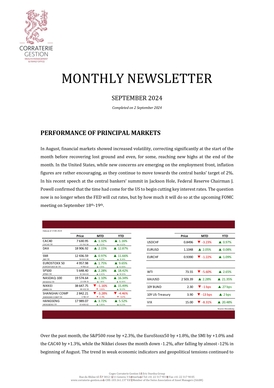1. PERFORMANCE OF PRINCIPAL MARKETS
In August, financial markets showed increased volatility, correcting significantly at the start of the month before recovering lost ground and even, for some, reaching new highs at the end of the month. In the United States, while new concerns are emerging on the employment front, inflation figures are rather encouraging, as they continue to move towards the central banks' target of 2%. In his recent speech at the central bankers' summit in Jackson Hole, Federal Reserve Chairman J. Powell confirmed that the time had come for the US to begin cutting key interest rates. The question now is no longer when the FED will cut rates, but by how much it will do so at the upcoming FOMC meeting on September 18th-19th.
Kindly refer to the link at the bottom of the page to view the table.
Over the past month, the S&P500 rose by +2.3%, the EuroStoxx50 by +1.8%, the SMI by +1.0% and the CAC40 by +1.3%, while the Nikkei closes the month down -1.2%, after falling by almost -12% in beginning of August. The trend in weak economic indicators and geopolitical tensions continued to underpin the rise in the price of gold, which rose by +2.3% over the month. At the same time, the yield on the 2-year Treasury note contracted by 34bps, while that on the 10-year fell by 13bps, allowing the yield curve to flatten to close to 3.90%.
2. ECONOMIC AND FINANCIAL ENVIRONMENT
In August, we witnessed the unwinding of part of the yen carry trade, phenomenon that sparked a surge in market volatility at the beginning of the month. For reference, this investment strategy that involves taking advantage of low interest rates to borrow in yen and reinvest in higher-yielding currencies, has generated interesting returns for investors over the past few decades. However, as this practice reached its peak, fueled by a significant interest rate differential due to divergent monetary policies between the Bank of Japan (BoJ), which kept its key interest rate at zero, and the FED, whose rates remain around 5.5%, the BoJ’s recent decision to raise its rates caught many investors by surprise and disrupted the strategy. As a result of this announcement, these investors were forced to sell off yen-denominated assets to repay part or all of the loans they had taken out, adding further pressure to financial markets already affected by the low liquidity typical of the summer period.
In the United States, inflation indicators for July are in line with expectations and continue to move in the right direction. The consumer price index (CPI) rose by +0.2% over the month and +2.9% year-on-year, compared with +3.0% the previous month. Core inflation, which excludes volatile food and energy prices, also rose by +0.2% over the month and +3.2% year-on-year, which was viewed positively by the financial markets. J. Powell also stated that although the task is not yet complete, considerable progress has been made towards the 2% inflation target.
Modest employment data for July have revived fears about the strength of the US economy. The data revealed the creation of 114’000 non-farm payrolls (NFP), below the 175’000 expected, concentrated in the healthcare (+55’000), construction (+25’000), government (+17’000) and transport (+14’000) sectors. At the same time, although it has gone almost unnoticed, the US Bureau of Labor Statistics has sharply revised downwards job creation for the period between March 2023 and March 2024, i.e. -818’000 jobs, or around -30%! This revision highlights a fundamental problem for central banks, which are forced to take crucial decisions based on unreliable economic indicators. Finally, the unemployment rate increased to +4.3%, up from +4.1% the previous month, confirming the accelerating deterioration of the job market. The average unemployment rate over the past three months is now more than 0.5% higher than the lowest quarterly average of the previous 12 months. The current level of this indicator, known as the “Sahm Rule”, has almost always preceded a recession. We will hence be watching its development very closely over the coming months.
As is the case every year, August was the scene of the central bankers' summit in Jackson Hole, at which J. Powell announced, to no real surprise, that the time had come to cut US key rates. The consensus is now for a cut of around 100bps (-1.0%) between now and the end of the year, with a cut of between 25bps and 50bps expected on 18th September. This announcement comes at a time when the job market is showing signs of weakness and the Leading Economic Index, an aggregate that weights 10 economic indicators in order of importance, is down -0.6% to 100.4, below the level seen at the low point of the Covid crisis in 2020 (100.5). At the same time, consumer confidence rose to 103.3, its highest level in six months, although this masked the fact that the confidence of low-income households was falling. Low-income households are increasingly facing financial difficulties, as evidenced by the recent results of Dollar General (DG), a low-cost US retailer, which significantly revised its forecasts for the current year due to declining demand. The current economic situation therefore remains difficult to read, but there is no denying that the signs of weakness are piling up.
Despite this, the "soft landing" scenario, which has been the consensus view for months, remains the preferred one. It seems that the prospect of an interest rate cut is blinding investors, who are convinced that the change in monetary policy alone will prevent a deterioration in the economic situation and allow the financial markets to continue their formidable path. In the short term perhaps, but we remain skeptical about the medium term, given that current valuations already anticipate strong monetary easing, and that earnings growth is struggling to justify market growth. Whatever happens, the Fed will have to manoeuvre very skillfully to avoid a scenario of stagflation or even recession.
3. OUR THOUGHTS AND ACTIONS
In the current environment, we are maintaining a neutral asset allocation, both in terms of exposure to risky assets and geographical spread. At the same time, with the cycle of interest-rate rises coming to an end and geopolitical tensions still rife, we are increasing our exposure to quality medium- and long-term bonds, to the detriment of the short term, while maintaining our investments in gold and oil.
4. THEME OF THE MONTH: ETFs
In recent years, passive investment via ETFs (Exchange-Traded Funds) has grown spectacularly. These funds, which faithfully replicate various indices, appeal to investors not only because of their performance, but also because of their low cost, transparency, and liquidity. This month, we look at what's really going on, as their popularity raises crucial questions about the true diversification they offer, their influence on the structure and quality of indices, and the risks associated with this type of investment vehicle.
There is no doubt that ETFs can offer several advantages that make them attractive to investors. First, numerous studies show that their performance has often outperformed that of active funds in the past, particularly when ETFs aim to replicate the performance of the main global indices, and more specifically those of large-cap US stocks. In addition, ETFs offer greater transparency, flexibility and liquidity. Unlike some active funds, they can be bought and sold in real time during market opening hours, enabling more dynamic portfolio management. For smaller investors, ETFs also represent an ideal solution for accessing diversification at lower cost, without the minimum capital requirements often found in active funds. These features make ETFs a simple and effective tool for building a diversified portfolio, even with limited resources. Finally, ETF management fees are generally much lower than for active funds, helping to maximize net returns for investors over the long term.
However, it is crucial not to invest blindly in this type of investment vehicle, as not all ETFs are created equal, and the mentioned advantages do not apply uniformly to all ETFs. These funds come in various categories, from ETFs that track traditional indices to thematic ETFs, leveraged ETFs, and inverse ETFs (short ETFs), each with different characteristics and risk levels. Thematic ETFs, in particular, require heightened vigilance. Although they allow investment in baskets of securities centered around a specific theme, often secular megatrends, they can offer illusory diversification. Despite comprising numerous underlying assets, these assets are often highly correlated, which makes diversification less effective while increasing volatility and, consequently, risk for the investor. As a result, while some themes may be appealing due to their potential for attractive long-term returns, this concentration can make these products unsuitable for certain investor profiles, especially those seeking genuine diversification to reduce their exposure.
It is also important to understand that leveraged and inverse ETFs can be illiquid and can potentially lead to significant losses, particularly during periods of high volatility. It is therefore essential to carefully assess the composition and structure (some do not apply physical replication) and objectives of each ETF before investing in it, taking into account your own risk profile and investment objectives.
Finally, increasing research is examining the impact of the growing dominance of passive investments on the quality of financial markets. The rising volume of index ETFs has a notable effect on market elasticity, amplifying movements both upward and downward. This phenomenon also tends to exacerbate market reversals by exposing investors to liquidity shocks. When markets are rising, investment flows into ETFs are automatically reinvested into the underlying assets (in the case of physical replication), particularly large-cap stocks that have a greater weight in indices. Consequently, these companies disproportionately benefit from this dynamic. However, during a market correction, the opposite effect occurs, leading to a more pronounced drop in prices.
According to the studies, this same phenomenon linked to investment flows also seems to have an impact on the quality of financial markets, because increased demand for these index funds artificially inflates the prices of the underlying companies, independently of their fundamental quality, thus creating a valuation bias. Investors hence buy poor-quality companies or sell good-quality securities every time a deal is struck.
In conclusion, although ETFs offer undeniable advantages in terms of cost and long-term performance, it is crucial for investors to understand the often-underestimated issues and risks associated with these products. A balanced diversification between passive and active funds within a portfolio seems to us to be an appropriate approach, allowing investors to benefit from the strengths of each strategy while mitigating potential weaknesses. ETFs can play an important role in diversification, but it is essential to choose the right indices to track. For example, ETFs that invest in exotic markets like Vietnam, or in small and medium-sized enterprises, have limited appeal in our view, as well-managed active funds are better equipped to capitalize on market inefficiencies. On the other hand, investing via an ETF in US large caps can be a smart move, especially as it allows to be more tactical during market phases. We therefore believe that we should not, as many do, oppose the two approaches, but rather combine them in order to benefit from the best of both worlds! To achieve this, careful selection and regular reassessment of choices are necessary to maximize returns and protect portfolios from the risks inherent in passive investing.




